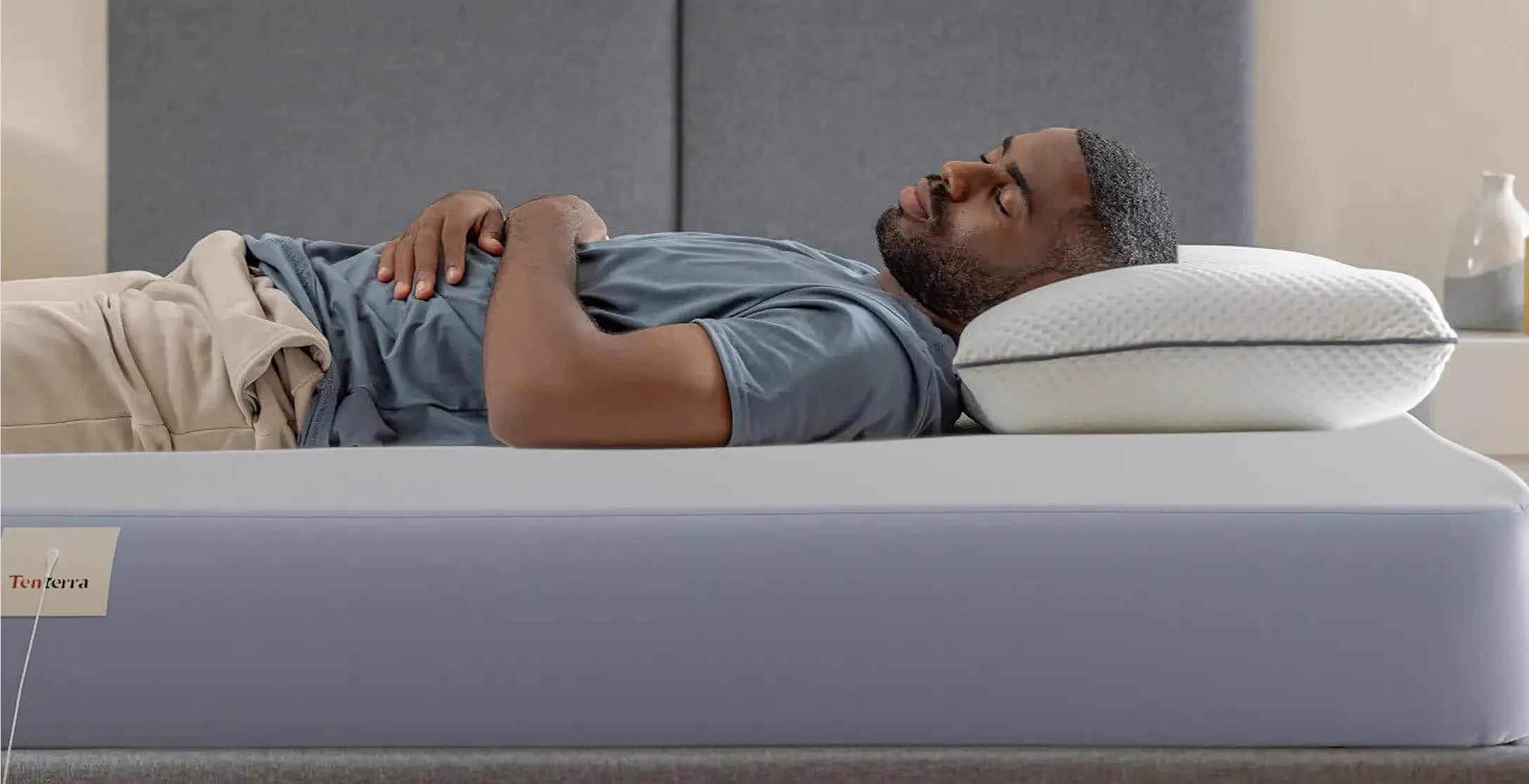
Grounding for Urban Dwellers: Combating EMF Exposure in City Environments
Share
Struggling with stress or sleep in the city? Learn how grounding can help you fight EMF exposure—backed by science, real stories, and practical solutions for every urban home.
I. Introduction: The Urban EMF Health Challenge
Did you know nearly 70% of the world’s population will be living in cities by 2050? While urban living brings innovation and excitement, it also creates a hidden health risk: constant electromagnetic field (EMF) exposure.
Whether you live in a high-rise, spend your days at a screen-filled office, or simply walk your dog past cell towers and WiFi signals, you’re in a modern “EMF soup.” Most of us aren’t aware of how much we’re affected.
The Urban Disconnect
City living means less time outdoors and more time insulated from the earth by concrete, synthetic shoes, and technology. As someone who measures EMF levels and tests grounding solutions for Tenterra, I’ve seen firsthand how urban environments can disrupt sleep, increase stress, and trigger “city fatigue.”
The solution?
Reconnecting to the Earth’s natural energy—even in the heart of the city.
II. Understanding Urban EMF Exposure
A. Sources of Urban EMF Pollution
-
Wireless Infrastructure:
Cell towers (especially 5G), WiFi networks, Bluetooth, IoT, and “smart city” tech surround us everywhere. -
Electrical Infrastructure:
Power lines, transformers, and LED streetlights all emit EMFs. Even in your own building, wiring and neighboring electronics raise background levels. -
Personal Devices:
Smartphones, wearables, laptops, and smart home tech mean our bodies are nearly always in close contact with EMF sources.
B. EMF Measurement and Exposure Levels
Studies show urban EMF levels can be 100–1,000x higher than rural areas (see source).
Hotspots: bedrooms near WiFi routers, offices with multiple devices, and public transit. Most people are surprised when they measure their own home or office with a simple EMF meter (see How to Measure EMF in Your Home).

C. Health Implications Research
Research links chronic EMF exposure to:
-
Sleep Disruption: Melatonin suppression, trouble falling asleep (Read: How Grounding Improves Sleep).
-
Stress & Cortisol: Higher stress hormones in high-EMF urban settings (Ghaly & Teplitz, 2004).
-
Inflammation: Raised markers of inflammation and immune response (Oschman, 2007).
-
Cognitive Issues: Reports of brain fog, trouble focusing, headaches.
-
Vulnerable Groups: Children, the elderly, pregnant women, and those with electromagnetic hypersensitivity (EHS) are especially at risk.
Case Study:
“After moving to a city apartment above a busy intersection, I struggled with sleep for months. It wasn’t until I measured EMF (and started grounding with a mat) that I saw a dramatic difference. My sleep improved and I woke up refreshed, not groggy.” — Case Studies
III. The Science of Grounding and EMF Protection
A. How Grounding Works
-
Your Body as a Conductor:
EMFs can create electrical charges in your body. Grounding neutralizes these by transferring them harmlessly into the earth. -
Antioxidant Effect:
Grounding delivers free electrons, which help neutralize EMF-triggered oxidative stress and inflammation ([Oschman, 2007]). -
Inflammation Reduction:
Research and personal experience show grounding reduces pain and supports the immune system, even in high-EMF areas (Chevalier et al., 2012).

B. Grounding & EMF: What the Research Shows
-
Sleep Quality: Grounding normalizes cortisol and improves deep sleep in high-EMF environments (Ghaly & Teplitz, 2004).
-
Heart Rate Variability: Improved in grounded individuals, signaling better stress recovery.
-
Mood and Immunity: Many report calmer moods, faster recovery from colds, and less “city fatigue.”
Explore More: 21 Science-Backed Benefits of Grounding Sheets
IV. Urban Grounding Challenges
A. Physical Barriers
-
Concrete, Asphalt, and High-Rises: Most urbanites rarely touch soil.
-
Limited Green Space: Parks are often crowded or far away.
-
Shoes & Clothing: Rubber soles block grounding; synthetic clothes increase static.
B. Environmental Concerns
-
Soil & Water Contamination: Urban soil may be polluted—direct contact is sometimes unsafe.
-
Time: Busy schedules mean less time outside.
C. Indoor Living Dominance
-
Most of us spend 90% of time indoors, cut off from earth’s natural electrons (Why Indoor Grounding Matters).
Use our Body Voltage Reduction Calculator for a personalized assessment.
V. Practical Grounding Solutions for City Dwellers
A. Indoor Grounding Systems
-
Grounding Mats & Sheets:
-
Plug into a properly grounded outlet (test with a simple plug-in checker).
-
Use at your desk, under your feet, or on your bed.
-
Personal Tip: I tracked my deep sleep and noticed a clear improvement after switching to a Tenterra sheet.
-
-
Patches & Bands:
-
Portable, discreet, and perfect for apartments or work.
-
Great for travelers, too.
-
Shop Urban Grounding Solutions
B. Apartment/Condo Solutions
-
Grounding with Outlets:
-
Use only verified, properly grounded outlets.
-
Landlord permission and professional installation are recommended.
-
-
Balcony/Patio:
-
Grounding mats or potted plants (moistened) can work as a grounding point.
-
-
Desk Setups:
-
Try a grounding mat under your keyboard and mouse.
-
C. Workplace & Shared Spaces
-
Desk-based mats and portable patches.
-
Advocate for EMF and wellness education at work.
-
Bring your own mat or patch to co-working spaces (see How to Ground at Work).
D. Mobile/Travel Grounding
-
Travel kits:
-
Bring a compact mat or band.
-
In hotels, always test the outlet.
-
-
Public Spaces:
-
Find clean grass in parks, or even just touch a living tree (bark, not leaves).
-
E. DIY and Budget-Friendly Ideas
-
Make your own simple grounding band (copper wire and a grounding plug, instructions in DIY Grounding: Safe Methods).
-
Gradual Implementation:
-
Start with the bedroom, then add desk and living areas as budget allows.
-
VI. Maximizing Grounding Benefits in High-EMF Environments
-
Timing:
-
30+ minutes/day is effective—overnight is ideal.
-
Integrate grounding with morning routines, work breaks, and sleep.
-
-
Synergy:
-
Combine grounding with EMF reduction for best results (How to Reduce EMF at Home).
-
-
Track Results:
-
Use sleep apps, mood journals, and EMF meters.
-
Look for gradual, consistent improvements.
-
VII. Safety Considerations and Best Practices
-
Electrical Safety:
-
Always test outlets and use GFCI protection.
-
Avoid grounding in wet conditions unless using products rated for outdoor use.
-
Consult with an electrician or professional if unsure.
-
-
Urban Environmental Safety:
-
Avoid questionable soil, busy roadsides, or contaminated parks.
-
Wash up after outdoor grounding in the city.
-
-
Medical Considerations:
-
Pacemaker or implant users: Consult your doctor first.
-
Start gradually and monitor how you feel.
-
See our troubleshooting Guide for Grounding in Apartments.
VIII. Case Studies and Success Stories
Urban Professional:
A Brooklyn marketing exec started using a grounding mat after measuring high EMFs in her apartment. After three weeks, she reported less anxiety, better sleep, and improved work focus. Her sleep tracker showed 40 minutes more deep sleep on average.
Night Shift Worker:
A Toronto ER nurse used a grounding band during her morning wind-down and saw her heart rate variability improve and sleep quality rise, even after stressful overnight shifts.
Family in a Condo:
A family of four used grounding sheets and a living room mat. Parents saw less “screen fatigue,” and kids slept more soundly. They shared their step-by-step approach on our case study page.
IX. The Future of Urban Grounding
-
Technology:
IoT-enabled grounding devices and real-time health tracking. -
Urban Design:
City planners are adding grounding zones to public spaces and green areas. -
Research:
Large-scale studies are underway (What’s Next for Grounding Science?).
X. Conclusion & Action Steps
Urban grounding is no longer a luxury—it’s a health necessity.
Whether you’re a skeptic or already a believer, there’s no downside to reconnecting with the Earth in a safe, practical way.
-
Start by assessing your own EMF exposure (Measure EMF in Your Home).
-
Add a grounding solution in your bedroom or workspace.
-
Prioritize safety and track your progress.
-
Join the growing Tenterra community for support, ideas, and updates (Join Our Community).
Ready to get started? Browse our tested urban grounding sheets.
References & Further Reading
-
Ghaly, M., & Teplitz, D. (2004). The biologic effects of grounding the human body during sleep as measured by cortisol levels and subjective reporting of sleep, pain, and stress. Journal of Alternative and Complementary Medicine, 10(5), 767–776.
-
Oschman, J. L. (2007). Can electrons act as antioxidants? Journal of Alternative and Complementary Medicine, 13(9), 955–967.
-
Chevalier, G. et al. (2012). Earthing: Health implications of reconnecting the human body to the Earth’s surface electrons. Journal of Environmental and Public Health, 2012.
-
World Health Organization. (2020). Electromagnetic fields and public health.
-
EPA (2022). EMF exposure and health.
Frequently Asked Questions about Urban Grounding & EMF Exposure
What is grounding, and how does it help with EMF exposure?
Grounding (also called earthing) involves making direct contact with the Earth’s surface or using products that connect you electrically to the ground. This allows your body to absorb free electrons, helping neutralize the electrical stress caused by exposure to electromagnetic fields (EMFs) common in cities. Research suggests grounding may reduce inflammation, improve sleep, and support overall well-being in high-EMF environments.
Can I ground myself if I live in an apartment or high-rise?
Yes! Even if you can’t access direct soil, you can use grounding sheets, mats, or bands plugged into a properly grounded outlet. Always use a ground tester to ensure your outlet is safe. Balcony and patio grounding (with moist potted plants or mats) can also work. See our infographic above for a step-by-step guide.
Is grounding safe for everyone?
Grounding is generally safe for most people. However, those with pacemakers, implanted devices, or serious medical conditions should consult their doctor before starting grounding routines. Always follow product safety instructions and avoid using electrical grounding products in wet conditions unless rated for outdoor use.
How long should I ground each day to see benefits?
Many users and studies suggest that 30 minutes to 1 hour of grounding daily is a good starting point. For sleep and recovery benefits, overnight grounding (using a grounding sheet while you sleep) is highly effective for urban dwellers.
Does grounding completely block EMF exposure?
No, grounding does not block EMFs. Instead, it helps the body neutralize the excess electrical charge caused by EMFs. For best protection, combine grounding with EMF reduction strategies, like moving electronics away from your sleeping area and using airplane mode at night.
Are grounding products effective for people living in cities?
Yes. Grounding products like mats and sheets have been shown in peer-reviewed research and customer case studies to help city dwellers sleep better, reduce stress, and feel more balanced—even in high-rise apartments with high EMF exposure.
What are the signs that grounding is working for me?
Common positive signs include better sleep quality, feeling more relaxed, reduced muscle tension or pain, improved mood, and fewer headaches. Some people notice results within days, while others see gradual improvements over weeks.
Can children and pets use grounding products?
Grounding is considered safe for children and pets, and many families report great results for kids’ sleep and focus, as well as calmer pets. Always use products as directed and consult with a healthcare professional for any concerns.


